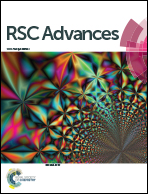Tuning the composition of rare earth sesquioxides Gd2−xLaxO3:Eu3+ to control phase transitions at a high temperature to design new highly sensitive luminescence-based thermal sensors
Abstract
The C-form (SG: Ia![[3 with combining macron]](https://www.rsc.org/images/entities/char_0033_0304.gif) ) → B-form (SG: C2/m) phase transition of RE2O3 rare earth sesquioxides is described for the first time for face centred cubic–hexagonal close-packed array transformations. Based on XRD data analysis, the temperature of the C → B phase transition in Gd2−xLaxO3 compositions (0 < x < 0.5) was controlled by adjusting the Gd/La atomic ratio and varies between 1100 °C and 1400 °C. Taking into account the various environments of rare earth oxides in C and B allotropic forms, Eu3+ was used as a local probe to obtain photoluminescence spectra (emission and excitation spectra, luminescence decay time curves). The spectra significantly changed during the phase transition, which occurred within a small temperature range. Furthermore, coupling Rietveld XRD data analysis for the long-range order signature with optical emission spectroscopy to probe the local environment provides a clear view of the C → B phase transition, allowing for the design of new highly sensitive thermal sensors at high temperatures.
) → B-form (SG: C2/m) phase transition of RE2O3 rare earth sesquioxides is described for the first time for face centred cubic–hexagonal close-packed array transformations. Based on XRD data analysis, the temperature of the C → B phase transition in Gd2−xLaxO3 compositions (0 < x < 0.5) was controlled by adjusting the Gd/La atomic ratio and varies between 1100 °C and 1400 °C. Taking into account the various environments of rare earth oxides in C and B allotropic forms, Eu3+ was used as a local probe to obtain photoluminescence spectra (emission and excitation spectra, luminescence decay time curves). The spectra significantly changed during the phase transition, which occurred within a small temperature range. Furthermore, coupling Rietveld XRD data analysis for the long-range order signature with optical emission spectroscopy to probe the local environment provides a clear view of the C → B phase transition, allowing for the design of new highly sensitive thermal sensors at high temperatures.


 Please wait while we load your content...
Please wait while we load your content...